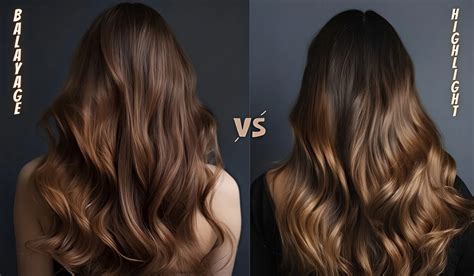Introduction:
When it comes to enhancing your hair with color, two popular techniques stand out: balayage and highlights. While both methods aim to add dimension and depth, they differ significantly in their application, results, and suitability. This article explores the key differences between balayage and highlights to help you make an informed choice for your next hair transformation.

Balayage: This French technique involves using a brush to hand-paint lightener onto sections of hair, creating soft, blended transitions and a more natural look. The colorist carefully selects the strands to be lightened, allowing for greater artistry and customization.
Highlights: On the other hand, highlights typically use foils to isolate sections of hair before applying bleach or lightener. The foils help to prevent the lightener from spreading to surrounding areas, resulting in more precise, contrasting highlights.
Balayage: Balayage creates a gradual transition of color from roots to ends, with lighter tones concentrated towards the mid-lengths and ends. This technique simulates the natural lightening effect of sunlight, resulting in a subtle, lived-in look.
Highlights: Highlights, on the other hand, provide a more consistent distribution of color throughout the hair. The foils ensure that the lightened sections are evenly spaced and defined, creating a more dramatic and visible contrast.
Balayage: Due to its blended nature, balayage requires less frequent touch-ups. The gradual transition of color makes regrowth less noticeable, allowing for longer intervals between appointments.
Highlights: Highlights require more regular maintenance as the contrast between light and dark sections becomes more apparent with regrowth. Typically, touch-ups are necessary every 6-8 weeks to maintain the desired look.
Balayage: Balayage is extremely versatile and can be tailored to suit a wide range of hair colors and textures. It can create subtle sun-kissed highlights or bold, statement-making looks, depending on the desired effect.
Highlights: Highlights offer less versatility compared to balayage. While they can create a variety of looks, they are primarily suited for creating more contrasted and defined results.
Balayage: Balayage tends to be more expensive than highlights due to its time-consuming application process. The cost varies based on the length and thickness of hair, as well as the skill and experience of the colorist.
Highlights: Highlights typically require less time to apply, resulting in a lower cost. However, it’s important to consider the need for more frequent touch-ups, which can increase the overall cost over time.
Balayage: Balayage is generally considered a less damaging technique than highlights because the lightener is applied only to selected strands of hair. The hand-painting method reduces the exposure of the entire head to chemicals.
Highlights: Highlights involve using foils to isolate sections of hair during the bleaching process. This can lead to more damage as the chemicals are in direct contact with larger areas of hair for longer periods.
Balayage: Balayage’s blended transition of color results in a gradual fade over time. As the hair grows, the lighter and darker sections become less contrasting, creating a more natural-looking result.
Highlights: Highlights maintain their sharp contrast for a longer period as the bleached sections remain distinct from the unbleached ones. However, they require more frequent touch-ups to prevent the regrowth from becoming too noticeable.
Tables for Comparison
| Feature | Balayage | Highlights |
|---|---|---|
| Application | Hand-painted | Foil-wrapped |
| Color Distribution | Gradual transition | Consistent distribution |
| Maintenance | Low | High |
| Versatility | High | Moderate |
| Cost | Higher | Lower |
| Damage | Minimal | Moderate |
| Longevity | Gradual fade | Sharp contrast |
Tips and Tricks for Deciding
- Consider your desired look: Do you prefer a natural, blended effect or a more contrasting, statement-making style?
- Think about your hair type and color: Balayage suits all hair textures and colors, while highlights are ideal for creating bold contrast on darker hair.
- Factor in your maintenance routine: Balayage requires less frequent touch-ups, while highlights need more regular maintenance.
- Discuss your options with a professional colorist: They can assess your hair and suggest the best technique for your individual needs.
Common Mistakes to Avoid
- Over-processing: Too much bleach can damage your hair and cause breakage.
- Choosing an inexperienced colorist: A skilled colorist is essential for achieving the desired results without compromising the health of your hair.
- Ignoring regrowth: Neglecting touch-ups can lead to an unkempt appearance and damage the hair.
- Trying to DIY: Balayage and highlights are complex techniques that require professional expertise. Attempting them at home can result in uneven color or damage.
Step-by-Step Approach
Balayage:
- Section off damp hair into quadrants.
- Using a brush, apply lightener to selected sections of hair in a sweeping motion.
- Leave the lightener on for the desired amount of time, depending on the hair’s porosity.
- Rinse and tone the hair to achieve the desired shade.
Highlights:
- Section off damp hair into small sections.
- Place foils between each section and apply bleach or lightener using a brush.
- Fold the foils over the hair and leave them on for the desired amount of time.
- Rinse and tone the hair to achieve the desired shade.
Conclusion
Balayage and highlights are distinct hair coloring techniques that offer unique results. Balayage creates a more natural, blended look with lower maintenance, while highlights provide a more striking contrast with higher maintenance. By understanding the key differences between these techniques, you can make an informed decision about which is the right choice for you and achieve your desired hair transformation.
